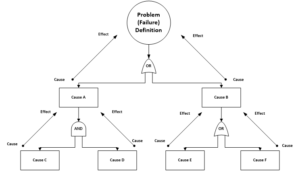This week’s tip finalizes our discussion on the Analysis phase of FRACAS, continuing with some of the different types of analysis tools which can be used to help determine the root cause.
Last week’s tip talked about the Cause and Effect Diagram, also known as the Fishbone or Ishikawa Diagram. For this week’s tip, we’ll talk about Fault Tree Analysis (FTA), Failure Mode, Effects and Criticality Analysis (FMECA) and Process Failure Mode, Effects and Criticality Analysis (PFMECA).
Fault Tree Analysis
Fault Tree Analysis is a visual, top-down deductive analysis tool that was developed in the early 1960s in the Aerospace and Defense industry and is widely used in system safety and reliability engineering. As with all the other analysis tools, the FTA starts with the problem (failure) definition. The FTA identifies, models and evaluates the unique interrelationship between possible causes leading to a failure event. They are most effective for complex system failures, and are typically used for high-hazard, high-risk failure events. FTAs are oftentimes used in complex system design along with FMEAs in order to better understand potential failure modes during the design phase. When used early in the design phase, the tool can help reduce, mitigate or even eliminate potential failures.
The FTA uses Boolean logic to investigate the possible causes of a failure event. In simple terms, an OR gate is used if the possible cause could produce the failure alone while an AND gate is used if one or more possible causes have to happen together to produce the failure. Figure 1 below is a simplified example of how to construct an FTA.

Figure 1: Simplified example of an FTA
Failure Mode, Effects and Criticality Analysis (FMECA) & Process Failure Mode, Effects and Criticality Analysis (PFMECA)
FMECAs and PFMECAs are extensions of FMEA and PFMEA respectively, with Criticality analysis added which is used to chart the probability of failure modes against their severity. The results of which highlight failure modes that have a high probability along with a high severity of consequences. This allows you to be able to prioritize and take action where the results will produce the greatest value. Both the FMECA and PFMECA are bottoms-up analysis tools with one being used for systems/equipment failures and the other used for … you guessed it! Process failures. In the case of FMECAs, they can be performed at the system/equipment function or component level. PFMECAs can be performed at the process function or process-step level.
Ideally, the FMECA or PFMECA is done at the system/equipment design or process design stage. This, of course, allows you to identify potential failure modes and eliminate, reduce or mitigate potential causes of failures before creating the system, equipment or process. Additionally, it provides a reference after design is complete and the system, equipment or process is in use. If a failure occurs, you’ll have a guide for verifying the actual failure mode as well as the potential causes.
Below are the objectives of an FMECA or PFMECA:
- Identify the system, subsystem or equipment mode of operation and/or process
- Identify potential failure modes and their causes
- Evaluate the effects on the system or process of each failure mode
- Identify measures for eliminating or reducing the risks associated with each failure mode
- Identify trials and testing necessary to prove the conclusions
- Provide information to the operators/users and maintainers so that they understand the capabilities and limitations of the system or process to achieve best performance
In order to conduct an effective FMECA or PFMECA, a team of Subject Matter Experts (SMEs) must be assembled. These are people that are familiar with the design, use, and or functions of the system, equipment or process the analysis is being conducted on. This type of analysis can be very time-consuming, depending on the complexity of the system, equipment or process. However, experience has shown that it is an extremely effective tool.
In next week’s tip, we’ll move into the Corrective Action phase of FRACAS.
© 2017 by LinRich Solutions, LLC. All rights reserved


